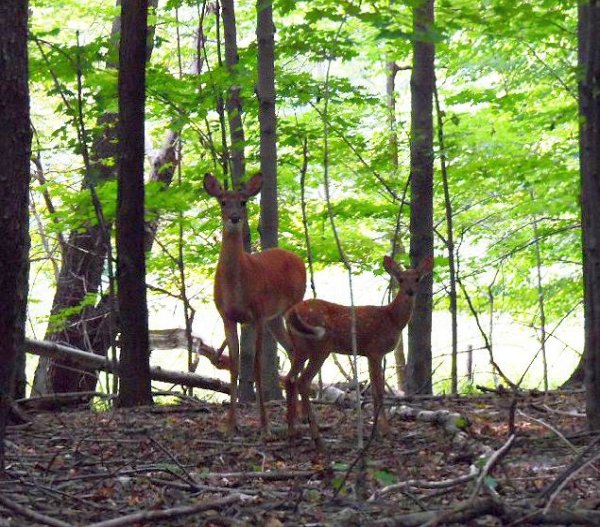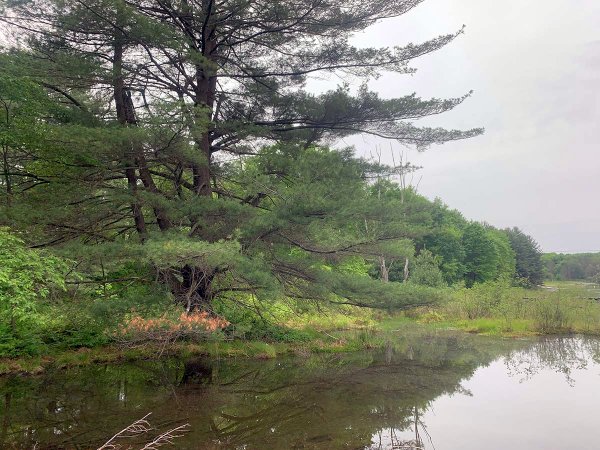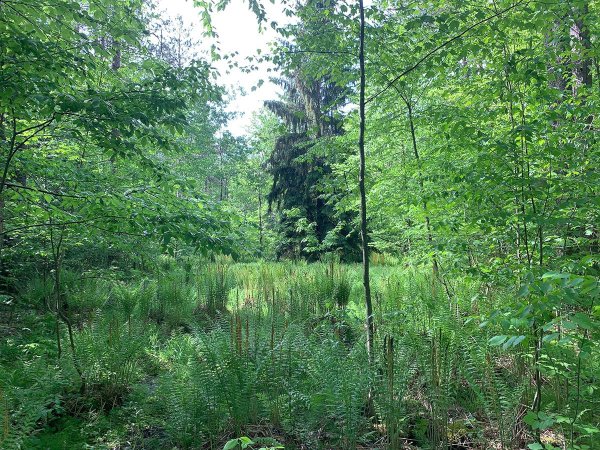Embracing the Wilds at Lughnasadh
- Details
- Written by Dana - Druids Garden

When you think of the term “wild”, what comes to mind? Perhaps wild can be defined by that which is its opposite: civilized, tame, domesticated, and controlled. Wild, on the other hand, is free, unrestricted, unbounded, and sovereign. And while I resist binaries, there does seem to be some truth in the difference between that which is wild and that which is tame–a manicured city street vs. an old-growth forest has a world of difference: in the smell, in the biodiversity present, and in the energy of the space.
A wild place is hugely biodiverse and serves the needs of a wide variety of species. A wild space is in a place of ecological balance, where all resources are cycled and used. The human-tamed spaces are most frequently designed for human needs exclusively, and in the modern age, are also prime producers of pollution and waste. There’s, of course, also a lot of spaces in between. What happens when we embrace some of this wildness and wilderness in our own lives? What can happen when we bring it back into our lives–both internally and externally–and allow nature to offer her wisdom?
Lughnasadh is a great time for this kind of work, here in the Northern Hemisphere, because this is a time when many of the plants and life are at their “peak” for the year. This is when the seed heads ripen, the fruits of the forest grow extremely abundant, and this is a time when the land is at its fullest and greenest of the year. In other words, if you want to embrace the wilds, starting at the peak time is a great time to do so.
Why embrace the wilds?
Embracing the wilds both within and without is important work in a few directions: the first is from a standpoint of global sustainability. Here in the US, over 80% of our population lives in urban areas–areas that are, essentially, the most catered to human needs, and when nature takes place in them, nature is tamed, shaped, and molded mostly to human needs. When nature is encountered, it is typically tamed and shaped, with only certain kinds of nature able to thrive (or adapt) in these settings. Take the lovely trees planted in lines on the edge of your street, or the carefully manicured lawns of suburbia. A lot of the most destructive practices currently that everyday people do are in the name of taming nature–spraying the weeds, mowing the grass, or otherwise preventing nature from “taking over.”While climate change is certainly one of the most dominant forces shaping the 6th mass extinction globally, it is also the loss of habitat–the conversion of wild spaces to human-centered domestic ones–that is also a leading factor. So thinking about allowing for more wild spaces, even in human-centered ones, is one way to help reverse the present course.
But there is a massive mindset component to not having the experience of wild spaces and wild nature close by or by being surrounded constantly by human-driven spaces. If 80% of the population of the US, and 50% of the population globally live in cities–more and more people in the world are experiencing almost no wild spaces on a daily basis. What happens, I believe, is that when we live in these spaces, we start to think that they are somehow “natural” because that’s always what we see. Think about lawns or carefully manicured streets–if you grew up seeing these every day, then that is “normalized” in your mind and that’s what you start to expect. In English, we can see that bias in our language away from undomesticated spaces in phrases like, “that yard is overgrown” or “too many weeds” or a wild space looks “unkempt” and even “yard waste”! This really does a number on our minds: it turns us away from nature and her healing wisdom and makes us privilege and believe (even subconsciously) that human-dominated spaces are what is normal or right. I think it could be time for a powerful shift in thinking!
 Wild spaces to run free
Wild spaces to run freeSo…enter rewilding and embracing the wilds. Creating space for wild spaces, untended spaces, and an untended and undomesticated way of thinking can greatly support any nature-based spiritual practice. So rather than sharing rituals for Lughnasadh, I’m sharing a set of practices you might do to bring some rewilding into your life!
Rewilding Nature and Rewilding Ourselves
 Wild edge on the lake
Wild edge on the lakeThis section offers some background on the ideas presented and also offers some basic definitions for the principle of rewilding. If you want to get right to the practices, go to the section below!
While definitions vary, the basic practices and assumptions of rewilding in nature is a particular approach to ecological conservation that recognizes that nature can take care of itself and works to reduce human control over land. That is, if an ecosystem is whole and functional, it is self-sustaining and does not require extensive human management (particularly “modern” management techniques which are often thinly veiled attempts at resource extraction, such as the “forest management” techniques we have here in the Allegheny mountains). Thus, rewilding techniques often include things like re-introducing apex predators (
on re-introducing Wolves to Yellowstone for a nice example of how this works), migration corridors, removing damns, and limiting human “management” techniques (especially as many of these are rooted not in care but profit). The whole premise re-frames nature as the one that has the ultimate wisdom about how to best thrive, and that natural spaces can be at their utmost health if they are allowed to be wild. Here in the US, the idea of rewilding is only starting to take off, but it’s much more prevalent in Europe and other places where much more of the landmass is taken up by people (for example, in the UK, only 13% of the landmass is forest, where here in the US about 33% is forested. Rewilding has a few principles worth sharing. Here in the US, there are still lots of wild places you can get lost in–forests, deserts, national reserved, BLM lands, and the like.One of the questions you might ask is, but what about other techniques like permaculture, organic gardening, etc? There is ample is room for both. Rewilding land management practices suggest that while much of our lands can be left to simply be wild, we are still in need of regenerative practices for how we live in our everyday spaces–our homes, our cities, our agricultural practices, etc. And it is in these human-dominated spaces that is where things like permauclture apply–they apply to the 1/2 acre garden, they apply to the city park, and they certainly apply to the suburban lawn. Permaculture also uses rewilding concepts–a perennial food forest is a wilder space that is planted and then managed primarily through harvest. I see both rewilding and permaculture as equally important in helping shape a balanced approach to life in the present and future.
Many folks who are into rewilding also recognize that this same practice can be applied to people. Modern civilization breeds a host of diseases of the body and mind that are products of the tight control of domestication: apathy, depression, feeling that life has no meaning, anxiety, fear, violence towards self and others, and obesity, to name a few. Civilization may have many benefits, but ultimately, we are just another animal on this planet, and much more of our evolution was spent living like another animal working with nature to provide our needs than living as the modern-day demands–disconnected from the living earth. In fact, culture sends this message strongly: that you are not whole, that you are not right as you are, but rather, you can only be fixed by this pharmaceutical, or product, or specialist service. The principle of rewilding suggests that everything you need for wholeness can be found in nature, and by experiencing nature closer and becoming more aligned with the wild parts of nature, you can heal yourself. It is beautifully aligned with nature spirituality and can take practices like druidry in some really fantastic directions. While there are varying degrees of personal rewilding practices, I’ll share a few here.
Enter the Wilds
The most basic rewilding practice you can do is simply to go into wild places and spend time there. In most places, there are different kinds of wild spaces, and learning about your local region can help you select spaces that are wilder to spend time in. Here in Pennsylvania, for example, we have different kinds of public lands that are managed in different ways. State parks are usually highly managed, state forests less so, and wilderness areas being the least of all managed. Pennsylvania currently has eighteen areas designated “Wilderness” areas that have no land management (detailed here). I’ve done overnight trips in three of these areas and they are so different in character than more managed spaces.
If you haven’t spent a lot of time in more wild spaces before, you might work yourself up to that. Start with camping in a campground, and then shift to more primitive camping where you bring your backpack and more minimal supplies. Find friends who have gear or are experienced in doing this. You can even work yourself up to more primitive camping once you’ve built up the skillset where you forage for food, build basic shelters, etc. The point here is to experience more of nature and less of the domestic spaces that dominate our lives.
So what do you do when you enter these wild spaces? The nice thing about them is that you’ll rarely encounter any other people if you’ve chosen carefully. My suggestion is to just be wild. Let loose. Be undomesticated. Have a joyful and fun time. Commune with nature. Recognize that you are part of nature–and experience that joy. And see the next section for more “wild” practices you can embrace.
Allowing Yourself to Be Wild
Spending some time in a wild and undomesticated state means throwing off the trappings of civilization and simply living in the moment. This kind of thing is best done in a wild space, but you can do it in a private setting of any kind (even a private backyard!). Let your inhibitions go–you can literally ritualize this where you envision yourself removing your inhibitions and behavioral norms and becoming free.
 Get to know some wild spaces, like this forest bog!
Get to know some wild spaces, like this forest bog!Swim naked in the stream. Paint yourself with berries and clay. Run naked in the rain and laugh as it hits your cheeks. Take off your shoes and climb on the rocks. Listen to the sound of the birds and call them in response. Pay attention to the movement of the animals and see if you can move like they do. Explore. Talk with the stones. Eat wild foods (those that you know, of course). Lay under the sun. Get dirty and muddy. Create a completely free and unstructured experience for yourself where you are deeply engaging with your senses and simply engaging in play. Spent time just moving–feel your body, be in your body. Run with the wind, jump, dance, sing as loud as you can, and just feel yourself being free.
A major change that can facilitate this wild state is removing footwear: try going barefoot or go with a pair of homemade moccasins. This past year, I’ve been wearing moccasins with increasing frequency to really feel the earth beneath my feet or going barefoot. If you want to go the moccasin route highly recommend the patterns from Earthing Moccasins –they are affordable and will protect your feet but still allow you to experience nature.
Also, turn your phone off or leave it at home. Don’t document your experience–simply live it. Live in the moment. This is a liberating ritual for yourself and doesn’t need to be documented and shared on social media. Put away the trappings of technology and simply be a primate living in nature!
If you notice, all of my suggestions above are embodied ones. Modern culture tries to disconnect us from our bodies through technology, long sedentary office jobs, and a whole set of expectations that keep us acting and thinking like everyone else. Remove those trappings as much as you are able to. Finding a way back into your senses, your body, and your status as part of nature can be so incredibly rich and healthful.
Rewilding the Mind
Rewilding is as much about inner change as it is about outer change. We can find ways of being more wild and free in part by changing our mindsets towards our daily life. It can be a good time to reflect on your own life–how can you bring a bit more nature, freedom, creativity, and wildness in? There is so much inner work that you can do on these topics, here are just a few ideas to get you started
- Recognizing the personhood and sovereignty of all living beings
- Learning to trust your intuition and your own inner knowing rather than paying attention to what external voices/society tells you
- Exploring and extending your relationship with nature in many different ways
- Exploring your subconscious through creative practices, dreams, and meditation
- Exploring and changing how language shapes our thoughts (and interrogating words like progress, growth, wild, unkempt, etc)
- Exploring and changing how we view wild and domestic spaces
For more in this line of thinking, you might want to see the online course “Surviving Civilization” by Rewild University, which helps you find ways of rewilding your life and thriving in a challenging time.
Perhaps this isn’t my typical “ritual” post for a holiday, but I think that we can expand and broaden our notions of nature spirituality by simply experiencing different ways of integrating ourselves back with the living earth. I would love to hear more from you–how have you rewilded your life? Have you participated in any rewilding projects? What benefits have you had from doing so?
Liked this article? Dive deeper into personal growth and wellness! Check out CrystalWind.ca for spiritual wisdom or explore AromaWorx.ca for natural well-being tips. Spread the positivity—share this with friends on their happiness journey!
Let’s Chat! Drop Your Thoughts Below! ![]()
Disclaimer
We are in compliance with, "Copyright Disclaimer Under Section 107 of the Copyright Act 1976, allowance is made for "fair use" for purposes such as criticism, comment, news reporting, teaching, scholarship, and research. Fair use is a use permitted by copyright statute that might otherwise be infringing. Non-profit, educational or personal use tips the balance in favor of fair use." All rights reserved go to their respective holders. We do not own the intellectual property shown on this website, the respective holders own that privilege unless stated otherwise. We do not endorse any opinions expressed on the CrystalWind.ca website. We do not support, represent or guarantee the completeness, truthfulness, accuracy, or reliability of any content or communications posted on CrystalWind.ca.
Disclaimers for CrystalWind.ca: All the information on this website is published in good faith and for general information purposes only. CrystalWind.ca does not make any warranties about the completeness, reliability, and accuracy of this information. Any action you take upon the information you find on this website (CrystalWind.ca) is strictly at your own risk. CrystalWind.ca will not be liable for any losses and/or damages
Latest Articles
Dive into the Mystical World of the Crystal Wind Oracle Deck!
Get All the Enchanting Details Now!
NEW Expanded Boxed Edition!
Now with 58 Cards for Richer Wisdom!

Imagine a world of inspiration and healing, free for all—made possible by YOU!
Donate Now—Ignite the Magic at CrystalWind.ca!

Epilepsy - Finding A Cure
Your donation can make a difference!
Help us find a cure – donate now!
Unlock Your Light: Join Lightworkers Worldwide on CrystalWind.ca!
Follow Us!
Featured This Month
Cancer Mythology
The Mythology of Cancer: A Celestial Tale of Loyalty and Sacrifice Among th... Read more
Lammas by The Hedgewitch
Although in the heat of a Mid-western summer it might be difficult to discer... Read more
Abalone Shell
Echos Of The Ancestors Abalone strengthens the structure of the body and th... Read more
Egyptian Zodiac/Astrology
Egyptian astrology was one of the earliest forms of astrology. The Egyptians w... Read more
Lugh - Celtic God Of The Sun
The god Lugh was worshiped in Ireland as a deity of the sun. This connection... Read more
Chalcedony
The Stone Of Orators Chalcedony was very popular as a decorative stone in ant... Read more
Sun in Cancer
Cancer Sun Sign Characteristics Overview The name "Cancer" comes from Latin, ... Read more














































